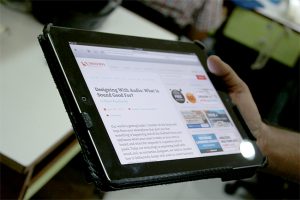Does Your Website Open On IPads & Mobile Phones? Do You Need Responsive Design
Two weeks back one of our clients was in complete dismay that the site we created for him did not open on his iPad. It took a while for us to make him understand that his entire site was built on Flash. He has not released the last installment of our payments. And the work ahead on promoting his brand is all stalled as he grapples with the fact that we will have to build another version for his site to open in hand held devices.
So, well yes, the big question: Do you need a website that will open in just about any device that one can access the Internet on?
But the bigger question: Do you need to make that extra investment in getting a responsive design for your website.
What Is Responsive Design
Its been doing the rounds on the web for a while, but for the uninitiated, here’s a quick note on it: Responsive design is a design that can adapt itself to any device. So based on the screen size of the device, as well as the technology on which it operates, this site will degrade gracefully.
Responsive design is built using languages such as HTML, HTML5, CSS3 and jQuery, and does not use Flash at all.



How Is Responsive Design Different from Web Design
Web design has been led by desktops and laptops that run on platforms that allow Flash. Second, there is fair standardization on screen resolutions (or sizes) and designs are done based on standard resolutions or to adapt to standard resolutions.
smashingmagazine.com on mobile phonesResponsive design takes it a step further. Foremost, it eliminates Flash! So Adobe does have some work to do here, and while they are, there are different languages that work to help your site adapt to any device. Our own website is built on part-responsive design. It adapts to tablets and the web, and smart phones. But we do have another mobile version too that addresses the lower end versions of the phone.
Do You Need Responsive Design?
This is a big question. The answer really lies in the profile of your target audience and their own usage habits of accessing Internet, are they likely to access it on-the-go, or are they sitting at homes and offices when they are likely to access your information. Second, what is the value per customer, and how large is your customer base. So if you are a B2C organization, a typical fast moving consumer goods company for instance, it is likely that a larger audience is on desk and laptops.
But if you are a financial services company with a B2B product and your TG is the white collared high profile jet-set executive he wants quick information on-the-go and is likely to be on tablets and definitely using the smart phone.
Want to know know how many of your existing audience attempts to access you from any handheld device? Check your Google Analytics. In the left-side menu, click on `Audience’. Browse the operating system and devices used by visitors to find your site. (Source: http://designmodo.com/responsive-design-business/#ixzz1sTELYrni )
How Interactive & Engaging Does Your Site Need To Be?
There is a reason that there are so many Flash developers out there, and while many may want to write them off today, fact is that the levels of interactivity and engagement that Flash can provide is still unmatched because more people today know how Flash works than those who can work on other languages. (Online gaming for instance is dominated by Flash.) If your audience base is largely on the desk and laptops, you may consider not opting for a Responsive Design, but not without the risk of losing the influential lot who may try to access you on-the-go. So have a version of your engagement program specifically built for the handheld devices.
But if your customer is on-the-go, or if your sales force is on-the-go and needs to share info, present your entire product line and service information on the move, then responsive design may be the answer.
For example our website uses Flash, but is programmed not to display the Flash part of the site on an iPad that does not support Flash. The resolution of the site is fluid, and adapts to various screen sizes automatically.
Note: If you are building a Flash site, then there should be alternative text based content so that when a user opens it on an iPad there is graceful degradation of the website.
What You Should Know When Making A Site for Handheld Devices
Excluding iOS (Operating Software for Apple Devices), there are also other OS for tablets like Blackberry (Playbook), Android with various versioning, etc. These tablets come in various sizes and based on these sizes come various resolutions. In such kind of scenarios there should be rigorous testing on various resolutions when your site is getting built.
One Size Fits All vis-a-vis Multiple Versions of your site
A good responsive design is more expensive than traditional Flash, that is, if you are expecting high end animation and transitions that are close to the experience that Flash animation can provide. But a basic website built on an HTML will be the least expensive.
It would be foolhardy to blindly opt for a Responsive Design and limit interactivity you can achieve on desk tops. Equally it would be fool hardy to blindly opt for multiple version of your website that is suited for various devices. A good approach would be to get multiple cost solutions and to clearly understand the design limitations as well as potential of each.

Thanks for these valuable information 🙂
future is for smart phone like iPhone and iPad, so Responsive Design is very right choice for the sites as the screen size is not too high to show real dynamic content provided by Flash…
It is very informative about what will be future technology but still flash has lots of features which existing technology needs to overtake flash.
Indeed right, thanks for the feeback
Nice information on responsive web design. And it is must specially for B2B